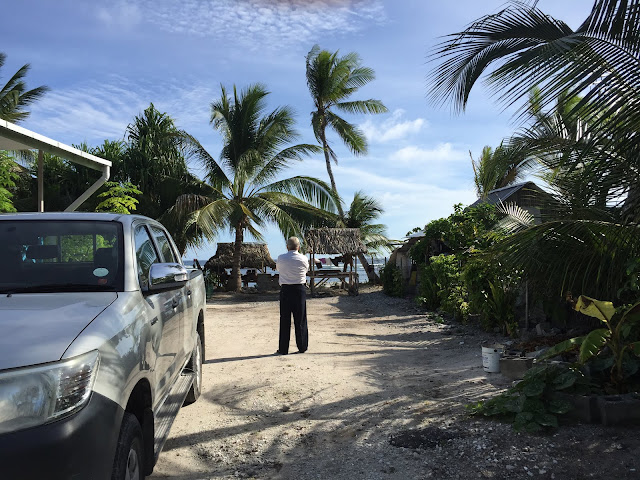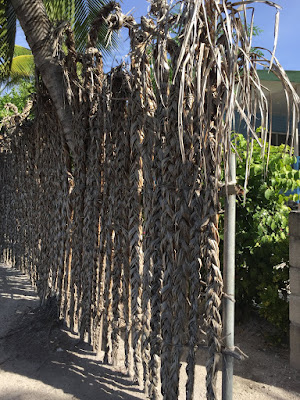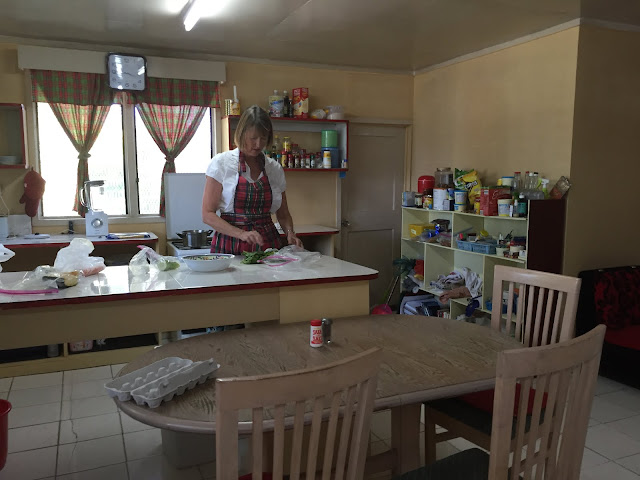Let us just say that we strongly feel that being able to visit the different islands in our area is critical
to understanding the great humanitarian work here in the Pacific.
Every island country is unique and has its own set of problems to solve.
As we counsel with each couple from our desks in the Area Office,
when we have actually been to the country of their mission,
when we have actually been to the country of their mission,
we are able to better envision the projects, the environment, and the people LDS Charities is trying to assist
. . . and that makes all the difference.
. . . and that makes all the difference.
In order to get to Kiribati, we had to fly from Auckland to Nadi, Fiji; spend the night in Fiji, and fly to Tarawa early the next morning. Planes only fly in and out of Tarawa on Mondays and Thursdays.
During our brief stop in Fiji, we happened to "run into" one of our couples traveling home - Lynn and Sandy Sanders who had been serving in the Solomon Islands. We were SO excited and surprised to meet them because we didn't think our paths would cross at all - It was fate! We spent a wonderful evening with them!
Flying into Bonriki Airport the next morning. As you can see, the island is VERY flat!
FOR YOUR INFORMATION:
FOR YOUR INFORMATION:
The nation of Kiribati comprises 32 atolls and reef islands and 1 raised coral island - 21 islands are inhabited. It is spread out over 1.3 million square miles and is the only country in the world within all 4 hemispheres! It is one of the least developed countries in the world and is a member of the United Nations.
Below is a map of the island of Tarawa.
To be more precise, Tarawa is an atoll,
which is a ring-shaped coral reef or series of islets; surrounding a lagoon.
Channels between the islets connect the lagoon to the open ocean.
(Most people refer to Tarawa as an "island" - so we will too!)
To be more precise, Tarawa is an atoll,
which is a ring-shaped coral reef or series of islets; surrounding a lagoon.
Channels between the islets connect the lagoon to the open ocean.
(Most people refer to Tarawa as an "island" - so we will too!)
South Tarawa is connected by a series of causeways.
You can only get to the northern part of the island by boat.
Here are two pictures from the internet to show you how NARROW the island is!
There is only one main road to drive on whenever you want to go anywhere.
"THE ROAD"!
A cute little girl walking on the side of "The Road"!
The Kitchen's
The Kitchen's
Here are Dan and Becky - Elder and Sister Kitchen! They are SO wonderful!
(In front of the main hospital and with Henry, the man working on one of our projects, an area clinic)
Notice that looking in one direction, you see the lagoon;
and looking in the other direction, you see the ocean!
The island here is definitely NOT very wide!
Their "caretaker" lives in the little house on stilts with the thatched roof (called a kia-kia) on the ocean side.

Just outside their driveway is the lagoon and . . . "The Road"!
We were fascinated by their beautiful "fence" woven out of coconut leaves.
And here is a picture of Sister Kitchen in her kitchen!
(You know, we HAD to say that! HaHa!)
Accommodations
We were VERY lucky to be able to stay in the best hotel on the island - the Utirerei (pronounced u-sir-re-see) Everyone seemed to know the Utirerei and Room #27! The motel/hotel is located directly behind the LDS Mission Office and the Mission President's home. President Larkin, who also presides over the Marshall Islands, was not in Kiribati while we were there.



The back of the Mission Presidents' Home

The view back to "The Road".




We thought our accommodations were lovely . . . and they were air-conditioned which is MOST unusual! The island of Tarawa was like an oven when we stepped outside and in minutes we became puddles of sweat! Haha! Even Texas hadn't prepared us for that (Yes, Kiribati is extremely HOT!!!)
. . . But we didn't complain
. . . We were in Kiribati and ready to "do some good" with our new friends, the Kitchens!
Learning Garden
. . . But we didn't complain
. . . We were in Kiribati and ready to "do some good" with our new friends, the Kitchens!
Learning Garden
Tioromaea, the director of the learning garden, came by the next morning to show us the new bicycle LDS Charities had given him so that he can visit garden projects around the island.
Tarawa is a coral atoll so the soil is extremely poor and it is very difficult to grow vegetables. Healthy food here is also hard to find in stores because most everything has to be imported. Tioromaea is teaching the people to grow gardens and to use fish for compost, but at the moment he is waiting for seeds to arrive for the next plantings. When we visited him at the garden, he climbed up a tree and gave us coconut water (nui) to drink. The missionaries also stopped by to say hello!
Tarawa is a coral atoll so the soil is extremely poor and it is very difficult to grow vegetables. Healthy food here is also hard to find in stores because most everything has to be imported. Tioromaea is teaching the people to grow gardens and to use fish for compost, but at the moment he is waiting for seeds to arrive for the next plantings. When we visited him at the garden, he climbed up a tree and gave us coconut water (nui) to drink. The missionaries also stopped by to say hello!
When we went "shopping" with the Kitchen's, they were able to buy fresh eggs at a local village, but couldn't find chicken or "meat" in the many stores we visited. Becky makes her own bread each week and uses freeze-dried food they brought with them in her meals. The people here, as in most of the islands, eat a lot of rice that is imported, fish from the sea, and fruit and vegetables they get from the land - Here on Tarawa - mostly coconuts.

Speaking of coconuts . . . We found three young boys up high in a coconut tree! There is one boy at the very top; kicking the coconuts loose with his feet and letting them fall down to his friends on the ground below!
Missionary Training
Since the Kitchens had only been in Kiribati for a month, we were happy to be able to train them in person. We used the internet at our hotel because the internet was "down" at the service center, which happens frequently here.
Humanitarian Projects in Kiribati
One of our responsibilities when we visit an island is to check on LDS Charities projects that have been completed and monitor projects that are in progress. Here are just a few:
LDS Charities built a sturdy seawall to secure housing along the coast.





To improve healthcare, LDS Charities is building a small clinic in Bonriki.
In this picture, Henry and his friend are busy tiling the floor.

Below, is a toilet block that was installed in the village of Ambo. The problem here is that the doors were locked and the village "chief" had the key!


 The children in the village began to multiply and soon Ral was surrounded! She taught the children to sing "Deep in the Heart of Texas" and they taught her "Are You Sleeping Brother John?"!
The children in the village began to multiply and soon Ral was surrounded! She taught the children to sing "Deep in the Heart of Texas" and they taught her "Are You Sleeping Brother John?"!

 There are many water tank projects in Ambo to provide better water for the people. On the island, you have to be very careful to drink only bottled or filtered water.
There are many water tank projects in Ambo to provide better water for the people. On the island, you have to be very careful to drink only bottled or filtered water.

 Pinto Katia is our CWM - Country Welfare Manager. He was very busy the week we were in Kiribati, because he is a member of Parliament and it was in session. We could only catch him on Sunday at church.
Pinto Katia is our CWM - Country Welfare Manager. He was very busy the week we were in Kiribati, because he is a member of Parliament and it was in session. We could only catch him on Sunday at church. 


One of our projects is a Diabetic Foot Clinic at the main hospital. The next two pictures show the main hospital and a second hospital we found on the other side of the island.



To improve healthcare, LDS Charities is building a small clinic in Bonriki.
In this picture, Henry and his friend are busy tiling the floor.

Below, is a toilet block that was installed in the village of Ambo. The problem here is that the doors were locked and the village "chief" had the key!


 The children in the village began to multiply and soon Ral was surrounded! She taught the children to sing "Deep in the Heart of Texas" and they taught her "Are You Sleeping Brother John?"!
The children in the village began to multiply and soon Ral was surrounded! She taught the children to sing "Deep in the Heart of Texas" and they taught her "Are You Sleeping Brother John?"!
Ambo had a wonderful community center and Don was fascinated by its sturdy construction - no nails!

 There are many water tank projects in Ambo to provide better water for the people. On the island, you have to be very careful to drink only bottled or filtered water.
There are many water tank projects in Ambo to provide better water for the people. On the island, you have to be very careful to drink only bottled or filtered water.
Below is a seawall made of bags of concrete we installed in the village.
The second picture is what it is like without a seawall.
("Kia-Kia" are the homes on stilts)

The daily laundry hanging out to dry
Happy children on their way to school
Everyday, in the evening when it is a little cooler - the favorite activity for youth is volleyball!
A little "Christmas" at the hotel and shopping in the town - no need for shoes
 Pinto Katia is our CWM - Country Welfare Manager. He was very busy the week we were in Kiribati, because he is a member of Parliament and it was in session. We could only catch him on Sunday at church.
Pinto Katia is our CWM - Country Welfare Manager. He was very busy the week we were in Kiribati, because he is a member of Parliament and it was in session. We could only catch him on Sunday at church. 
The Parliament Building is impressive, but the nicest buildings on the island are built by churches. LDS buildings are very nice, especially the Moroni High School campus, where the Service Center is located.
There is an especially beautiful LDS Church building on a point overlooking the sea
The Battle of Tarawa
On this island, in November of 1943, the "toughest battle in Marine Corps history" was fought. Tarawa was the most fortified atoll during the Pacific campaign and the Battle of Tarawa was the first American offensive and the first time in the "Pacific War" that the US faced serious Japanese opposition to an amphibious landing. Previous landings met little or no resistance, but on Tarawa the 4,500 Japanese defenders were well-supplied and well prepared, and they fought almost to the last man, exacting a heavy toll on the US Marine Corps. In only 76 hours, nearly 6,400 soldiers from both sides died in the fighting.
There are still remnants of the battle on the coast. One of huge Japanese bunkers is in the parking lot of an LDS Stake Center which is being built. It can't be moved or destroyed because of its historical significance. We jokingly said that the Primary could meet in it - the children would love it!
This is a ship that was brought ashore during a storm surge.
The seawalls protect the island from being completely over-run by the sea. Coral atolls are actually in danger of sinking. The pictures below show an intact seawall and one that has deteriorated.
Enjoying Kiribati
We so enjoyed training the Kitchens and having them teach us about the country of Kiribati. It is a very poor and run-down country to Western eyes and most every commodity has to be imported. It is not lush and full of fruits and vegetables like some of the other island countries - every day life is a little more difficult - but the people are dear and love their country just like any of us love our home country.
We enjoyed meeting and "hanging out" with the Senior Missionaries on the island. They get together most every week at one of the three restaurants on the island that are deemed "safe" to eat in!
One of the restaurants had one of the largest hamburgers we have ever seen! . . . and, we think, the ONLY diet Coke on the island! Don was ecstatic!
Leaving Kiribati
At the end of four days, we left the island. We wanted to show you a few pictures of the "International" airport - not something we are all used to!
We met this lovely Mormon family going to Fiji for a wedding. Fiji has the closest LDS Temple for the people of Kiribati. The boy with the longhorn shirt got a kick out of the fact that we were from Texas! Notice the beautiful smock-top dresses the two ladies and the little girl are wearing. They are typical Kiribati - they either have the person's name on them or the name of their village or country.
It started to rain as our plane pulled away.
Goodbye for now, Kiribati.
In your people, we found joy.
In your poverty, we found beauty.
You have won a place in our hearts.















































































